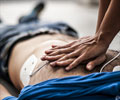Scientists say that cardiac arrests which can be treated by electric stimulation, also known as shockable arrests, were found at a higher frequency in public settings than in the home.

In every scenario, a higher percentage of public cardiac arrests were classified as ventricular tachycardia (VT) or ventricular fibrillation (VF), the types of abnormal heart rhythms that can be treated by electric shock.
More than one-third of the people who had a cardiac arrest in public and were treated with an AED survived. In comparison, the overall survival for home-occurring cardiac arrests treated with an AED was 12 percent.
The study conducted the National Heart, Lung, and Blood Institute (NHLBI), part of the NIH, is based on data from the world's largest data registry of pre-hospital cardiac arrest and life-threatening trauma, which is part of the Resuscitation Outcomes Consortium (ROC).
The researchers collected cardiac arrest data for over 14,000 people between Dec. 2005 and April 2007. The data spanned over 200 EMS agencies and their receiving hospitals across the United States and Canada.
Among the key findings were that 79 percent of documented cardiac arrests in high-traffic public places where AEDs were available and administered, such as airports or office buildings, were VT or VF.
Advertisement
The study appeared in the Jan. 27 issue of the New England Journal of Medicine.
Advertisement














